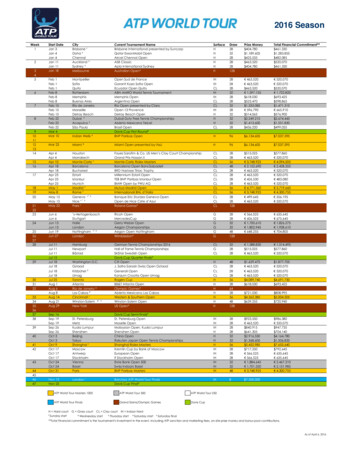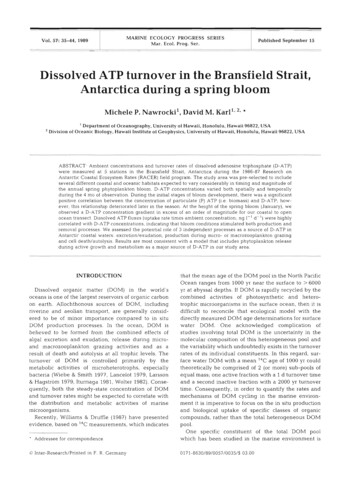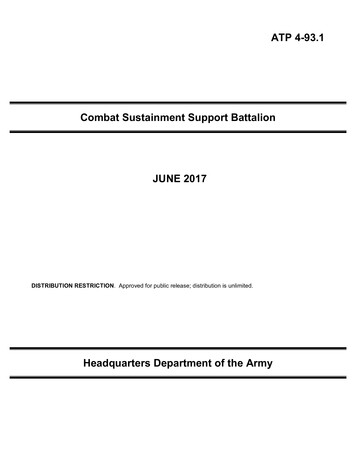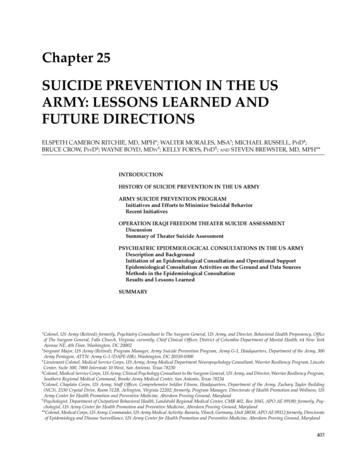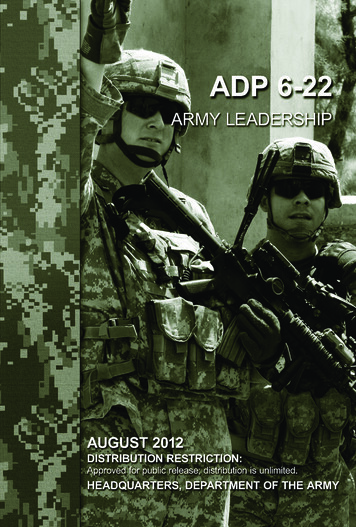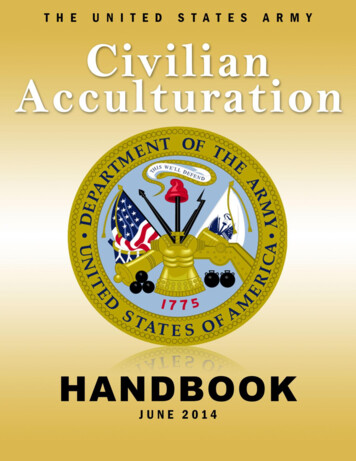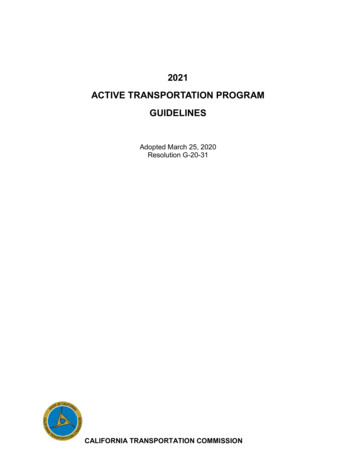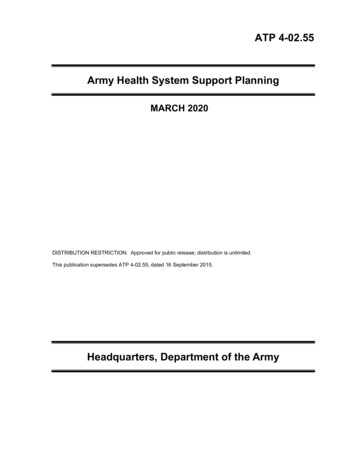
Transcription
ATP 4-02.55Army Health System Support PlanningMARCH 2020DISTRIBUTION RESTRICTION: Approved for public release; distribution is unlimited.This publication supersedes ATP 4-02.55, dated 16 September 2015.Headquarters, Department of the Army
This publication is available at the Army Publishing Directoratesite (https://armypubs.army.mil), and the Central Army Registrysite (https://atiam.train.army.mil/catalog/dashboard).
*ATP 4-02.55Army Techniques PublicationNo. 4-02.55HeadquartersDepartment of the ArmyWashington, DC, 30 March 2020Army Health System Support PlanningContentsPagePREFACE. viiINTRODUCTION . ixChapter 1ARMY HEALTH SYSTEM IN UNIFIED LAND OPERATIONS . 1-1Section I – The Role of Army Health System . 1-1Doctrine . 1-1Army Health System . 1-1Roles of Medical Care . 1-4Section II — The Application of Army Health System . 1-6Chapter 2ARMY HEALTH SYSTEM MEDICAL FUNCTIONS . 2-1Section I – Medical Command and Control . 2-1Medical Command and Control Organizations. 2-1Communications . 2-4Primary Task and Purpose . 2-5Section II — Medical Treatment (Organic and Area Support) . 2-5Organization and Personnel . 2-5Primary Task and Purpose . 2-6Section III — Medical Evacuation . 2-6Medical Evacuation System . 2-6Planning Medical Evacuation . 2-7Organizations . 2-7Primary Task and Purpose . 2-7Evacuation Precedence. 2-8Responsibilities . 2-8Theater Evacuation Policy . 2-8Combat Support Hospital and Hospital Center . 2-10Augmentation Teams . 2-11Primary Task and Purpose . 2-11Section V — Dental Services . 2-12Categories of Dental Care . 2-12Primary Task and Purpose . 2-13Section VI — Preventive Medicine Services . 2-13Organization and Personnel . 2-14DISTRIBUTION RESTRICTION: Approved for public release; distribution is unlimited.This publication supersedes ATP 4-02.55, dated 16 September 2015.ATP 4-02.55i
ContentsPrimary Task and Purpose . 2-14Section VII — Combat and Operational Stress Control . 2-15Organization and Personnel . 2-15Primary Task and Purpose . 2-15Section VIII — Veterinary Services. 2-16Veterinary Functions . 2-16Primary Task and Purpose . 2-16Section IX — Medical Logistics . 2-18Medical Logistics Functions . 2-18Primary Task and Purpose . 2-19Section X — Medical Laboratory Services . 2-20Clinical Laboratory Services . 2-20Area Medical Laboratory Services . 2-20Primary Task and Purpose . 2-21Chapter 3Army Health System Support Plans and Orders . 3-1Section I – Principles of planning . 3-1Section II — Army Health System Support Planning . 3-2Section III — The Army Health System Support Estimate . 3-4Format of the Army Health System Support Estimate . 3-4Mission . 3-11Courses of Action . 3-11Army Health System Support Analysis . 3-11Evaluation and Comparison of Courses of Action . 3-13Conclusion . 3-13Section IV — Running Estimate . 3-13Section V — The Army Health System Support Plan and Order. 3-14Preparation of the Plan . 3-14Responsibility . 3-14Purpose and Scope. 3-15Format . 3-15Chapter 4Computations . 4-1Section I – Terminology . 4-1Casualty . 4-1Hostile Casualty . 4-1Nonhostile Casualty . 4-2Section II — Classification of Patients. 4-3Army Health System Support for Other Special Category Patients. 4-4Army Health System Support for Enemy Prisoners of War . 4-4Section III — Patient Admission Rates . 4-4Section IV — Patient Admission Rate Computation . 4-6Section V — Calculation of Patient Evacuation Requirements . 4-6Ambulances . 4-6Air Ambulances . 4-7Time Factors . 4-8Computations . 4-8Section VI — Automated Methodologies . 4-12Development of Methodologies . 4-12Medical and Casualty Estimator Tool . 4-13Medical Planners’ Tool Kit . 4-13iiATP 4-02.5530 March 2020
ContentsJoint Medical Planning Tool. 4-14Disease and Nonbattle Injury Estimation . 4-14Chemical, Biological, Radiological, and Nuclear Casualty Estimator . 4-14Base Camp Planning . 4-14Medical Intelligence . 4-15Appendix AARMY HEALTH SYSTEM ESTIMATES . A-1Appendix BPATIENT RATE COMPUTATIONS . B-1Rates .B-1Calculating a Rate .B-1Rates Defined .B-1Appendix CARMY HEALTH SYSTEM OPERATIONS ORDER . C-1Example of an Operation Order Format . C-1Appendix DCALCULATION OF HOSPITAL BED REQUIREMENTS . D-1Application of Methodology . D-1Estimation of Enemy Prisoner of War Bed Requirements . D-17Statistics . D-17Changes in Evacuation Policy . D-18Appendix EARMY HEALTH SYSTEM CAPABILITIES .E-1Appendix FARMY HEALTH SYSTEM ALLOCATION . F-1Appendix GEVACUATION CAPABILITIES LOCATION . G-1Appendix HMEDICAL SITUATION REPORT . H-1Appendix IMEDICAL STATUS REPORT . I-1Appendix JJOINT MEDICAL CAPABILITIES . J-1Roles of Care Comparison . J-1Service Medical Support to United States Army . J-1GLOSSARY . Glossary-1REFERENCES . References-1INDEX . Index-1FiguresFigure A-1. Sample format for an Army Health System support estimate .A-1Figure C-1. Example of an operation order format. C-1Figure J-1. Air expeditionary wing structure . J-9Figure J-2. USAF medical capabilities . J-10TablesIntroductory Table-1 . xTable 3-1. Sample strengths to be supported matrix . 3-8Table D-1. Example accumulation and disposition factors‒combat zone . D-2Table D-2. Example accumulation and disposition factors‒theater . D-3Table D-3. Dispersion allowance and factor conversion table . D-430 March 2020ATP 4-02.55iii
ContentsTable D-4a. Disease and nonbattle injury patient admission rates‒Desert Shield/Storm, Bosnia,Kosovo, Operation Iraqi Freedom/Operation New Dawn, Operation Enduring Freedom(admissions per 1,000 strengths per day) as of April 2014. D-5Table D-4b. Patient admission rates‒Overall in World War II, Korean Conflict, and VietnamConflict (admissions per 1,000 strengths per day) . D-6Table D-4c. Patient admission rates-Europe, World War II (admissions per 1,000 strengths perday). D-7Table D-4d. Patient admission rates-Italy, World War II (admissions per 1,000 strengths perday). D-8Table D-4e. Patient admission rates‒Mideast Wars (between opposing non-U.S. forces)(admissions per 1,000 strengths per day) . D-8Table D-4f. Patient admission rates‒Central and South Pacific, World War II (admissions per1,000 strengths per day) . D-9Table D-4g. Patient admission rates‒Southwest Pacific, World War II (admissions per 1,000strengths per day) . D-9Table D-4h. Patient admission rates‒Korean Conflict (per 1,000 strength per day) . D-10Table D-4i. Patient admission rates‒Vietnam Conflict (per 1,000 strength per day). D-10Table D-5. Example problem statement . D-12Table D-6. Example of preliminary bed requirement information (problem statement graphicallydepicted) . D-13Table D-7. Example calculations of operations area bed requirements at end of each 30-dayperiod. D-14Table D-8. Example for obtaining operations area average daily admissions . D-15Table D-9. Example for finding accumulation factors . D-15Table D-10. Example for obtaining total operation area patients remaining (period 1) . D-16Table D-11. Example for obtaining total operation area patients remaining (period 2) . D-16Table D-12. Example for obtaining total operation area bed requirements (period 1) . D-16Table D-13. Example for obtaining total combat bed requirements (period 1) . D-17Table D-14. Estimate of enemy prisoner of war bed requirements . D-17Table D-15. Rate of admission to hospitals per 1,000 strength per day . D-17Table D-16 Effects of a Reduction in Theater Evacuation Policy on Bed Requirements . D-18Table E-1. Example of Army Health System capabilities . E-1Table F-1. Army Health System organization basis and rules of allocation—major combatoperations . F-1Table F-2. Army Health System organization basis and rules of allocation special operationsforces and stability . F-3Table G-1. Army medical evacuation capabilities .G-1Table G-2. Army casualty evacuation capabilities .G-2Table H-1. Medical situation report . H-1Table I-1. Medical status report . I-1Table J-1. United States military roles of care .J-1Table J-2. United States Navy and Marine Corps casualty evacuation capabilities.J-2Table J-3. United States Navy ship capabilities and staffing .J-3Table J-4. USAF floor loading capacity .J-7ivATP 4-02.5530 March 2020
ContentsTable J-5. USAF aircraft capacity. J-830 March 2020ATP 4-02.55v
This page intentionally left blank.
PrefaceArmy Techniques Publication 4-02.55 provides guidance to the medical commander, medical planner, andcommand surgeon at all levels of command in planning Army Health System support. Users of ArmyTechniques Publication 4-02.55 must be familiar with unified land operations established in Army DoctrinePublication 3-0; the operations process as stated in Army Doctrine Publication 5-0; how Army forces conductlarge-scale combat operations described in Field Manual 3-0; Army plans and orders production aspromulgated in Field Manual 6-0; mission command systems of tactical units and the mission commandprocess established in Army Doctrine Publication 6-0; Army Health System support described in FieldManual 4-02; and the Joint Health Services described in Joint Publication 4-02.The principal audience for this publication is all medical commanders, command surgeons, and their staffs,and nonmedical commanders involved in medical planning.Commanders, staffs, and subordinates ensure their decisions and actions comply with applicable UnitedStates, international, and in some cases, host-nation laws and regulations. Commanders at all levels ensuretheir Soldiers operate in accordance with the law of war and the rules of engagement.(See Field Manual 6-27/MCTP 11-10C.).This publication implements or is in consonance with the following North Atlantic Treaty OrganizationStandardization Agreements and American, British, Canadian, Australian, and New Zealand Publication 256,Coalition Health Interoperability Handbook.TITLENATO STANAGsForward Aeromedical Evacuation—Allied Aeromedical Publication-1.52087Allied Joint Doctrine for Medical Support—Allied Joint Publication-4.102228The Medical Management of Chemical, Biological, Radiological, andNuclear Casualties—Allied Medical Publication-7.12461NATO Planning Guide for the Estimation of Chemical, Biological, Radiologicaland Nuclear (CBRN) Casualties—Allied Medical Publication-7.52553Commander’s Guide on Medical Support to Chemical, Biological, Radiological,and Nuclear (CBRN) Defensive Operations—Allied Medical Publication-7.62873Aeromedical Evacuation—Allied Aeromedical Publication-1.13204This publication uses joint terms where applicable. Selected joint and Army terms and definitions appear inboth the text and the glossary. For definitions shown in the text, the term is italicized and the number of theproponent publication follows the definition. Unless this publication states otherwise, masculine nouns andpronouns do not refer exclusively to men.Army Techniques Publication 4-02.55 applies to the Active Army, Army National Guard or Army NationalGuard of the United States, and the United States Army Reserve unless otherwise stated.The proponent and preparing agency of this publication is the United States Army Medical Center ofExcellence, Doctrine Literature Division. Send comments and recommendations on a Department of theArmy Form 2028 (Recommended Changes to Publications and Blank Forms) to Commander, UnitedStates Army Medical Center of Excellence, ATTN: MCCS-FD (Army Techniques Publication4-02.55), 2377 Greeley Road, Building 4011, Suite D, JBSA Fort Sam Houston, Texas 78234-7731;by e-mail to ne@mail.mil; all recommended changesshould be keyed to the specific page, paragraph, and line number. A rationale for each proposed change isrequired to aid in the evaluation and adjudication of each comment.30 March 2020ATP 4-02.55vii
This page intentionally left blank.
IntroductionArmy Techniques Publication 4-02.55 updates Army Health System planning topics while adopting currentterminology and concepts as necessary. The Army Health System is a complex system of interrelated andinterdependent systems which provides a continuum of medical treatment from point of injury or woundingthrough successive roles of medical care and is inextricably linked to the Military Health System through theDefense Health Agency Role 4 Hospitals for the provision of definitive care as patients are evacuated tocontinental United States from Role 3 medical treatment facilities in theater.The medical planner is able to provide the best possible Army Health System for all Army operations by carefullyapplying operational medicine doctrine and principles. The Army Health System provides support to forcesdeployed across the full range of military operations in all operational arrangements. The Army Health Systemis a complex system of highly synchronized, interrelated, and interdependent systems comprised of ten medicalfunctions. The medical functions align with medical disciplines and specialty training with the capabilitiesrequired to provide state-of-the-art care to Soldiers regardless of where they are deployed or assigned.Summary of changes include – Designating this publication as the proponent for patient estimate from FM 4-02. Aligning this publication with FM 3-0 and FM 4-0. Providing medical planning factors in six additional appendixes.Army Techniques Publication 4-02.55 consists of four chapters and ten appendixes as follows:Chapter 1 provides an overview of the characteristics of the Army Health System, its principles, functions, therole of medical care, and medical planning factors. It also discusses the fundamental aspects used by medicalplanners to determine the best possible Army Health System to support Army operations.Chapter 2 describes the ten medical functions and how they are aligned with specific medical disciplines ofhealth service support or force health protection tasks. It also provides the primary purposes of the functions togive the medical planner a planning reference point to work from.Chapter 3 provides guidance for some of the unique complexity inherent to Army Health System planning. Italso provides a brief review of and references the Army planning process and how it applies to Army HealthSystem planning.Chapter 4 discusses some of the many different and unique factors, terms, and computations the medical plannercan use to develop the Army Health System support estimate.Appendix A provides a detailed example of the Army Health System support estimate with planningconsiderations.Appendix B provides an explanation of rate calculations and provides some of the more commonly used rateformulas.Appendix C provides an example and guidance on the preparation of an Army Health System appendix to anoperation order or operation plan.Appendix D provides a methodology to manually calculate hospital bed requirements. It includes current andhistorical information to perform the calculations to assist in preparing the Army Health System support estimate.30 March 2020ATP 4-02.55ix
IntroductionAppendix E provides an example of Army health system unit capabilities for mission analysis and planningpreparation of an Army healthy system appendix to an Operation order or Operational plan.Appendix F depicts the allocation of medical capabilities, organized by unit type and operation to provide a quickreference for mission analysis and assist in planning preparation.Appendix G provides medical and casualty evacuation capabilities to assist planners in determining capacitybased on the number and type of vehicles available.Appendix H provides a format for a medical situation report to convey a quick, consolidated medical status reportas a snapshot instead of a full report.Appendix I provides a format for the medical status report for hospitalization, disease, and issues having animpact on medical capability or health of the command.Appendix J provides an overview of the medical capabilities and capacities of the United States Navy, Marine,and Air Force.Based on doctrinal changes, terms for which Army Techniques Publication 4-02.55 is now the proponent havebeen added for the purpose of this publication. The glossary contains acronyms and defined terms. SeeIntroductory Table -1 listed below for specific term changes.Introductory Table-1Termpatient estimateRemarksATP 4-02.55 is now the proponent.Legend:ATP Army Techniques PublicationxATP 4-02.5530 March 2020
Chapter 1Army Health System Support in Unified Land OperationsThis chapter provides an overview of the characteristics of Army Health System(AHS), its principles, functions, the roles of medical care, and medical planningfactors. It also discusses the fundamental aspects used by medical planners todetermine the best possible AHS to support Army operations.SECTION I – THE ROLE OF ARMY HEALTH SYSTEM1-1. A characteristic of the AHS is the distribution of medical resources and capabilities to provide roles ofmedical care. Policy provides the framework from which the medical community derives the direction andidentifies the requisite personnel, materiel, facilities, and information systems to promote, improve, conserve,or restore well-being.DOCTRINE1-2. The capstone doctrine for the United States Army doctrinal guidance and direction for conductingunified land operations is Army Doctrine Publication (ADP) 3-0. This has been augmented by Field Manual(FM) 3-0 which describes how the United States Army conducts its strategic roles in support of the jointforce to shape the operational environment, prevent conflict, conduct large-scale combat operations, andconsolidate gains.1-3. The Army medical capstone doctrine is contained in FM 4-02. Other supporting medical doctrine isfound in applicable Army Techniques Publication (ATP). This chapter provides the broad doctrinal guidanceand philosophy for conducting AHS support in unified land operations.ARMY HEALTH SYSTEM1-4. The Army Health System is a component of the Military Health System that is responsible foroperational management of the health service support and force health protection missions for training,predeployment, deployment, and postdeployment operations. Army Health System includes all missionsupport services performed, provided, or arranged by the Army Medical Department to support health servicesupport and force health protection mission requirements for the Army and as directed, for joint,intergovernmental agencies, coalition, and multinational forces (FM 4-02). Although the Military HealthSystem is an interrelated system which may share medical services, capabilities, and specialties among theUnited States (U.S.) Service components, it is not a joint mission command system. For information on jointhealth service support (HSS) refer to Joint Publication (JP) 4-02.1-5. The AHS is a complex system of systems, divided into ten medical functions which align with medicaldisciplines. These systems are interrelated and interdependent and must be meticulously and continuouslysync
and Nuclear (CBRN) Casualties—Allied Medical Publication-7.5 2553 Commander's Guide on Medical Support to Chemical, Biological, Radiological, and Nuclear (CBRN) Defensive Operations—Allied Medical Publication-7.6 2873 Aeromedical Evacuation—Allied Aeromedical Publication-1.1 3204 This publication uses joint terms where applicable.
